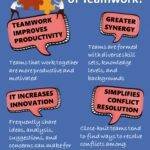
The History of Team: Theory and Research
The source of the stream of research on teams can be traced to the Hawthorne studies which established the importance of intergroup relations in organizations, the influences of teams on their members, and the importance of informal groups in influencing work related behavior.
Two strands of thought about teams emerged in the 1960s and 1970s. The first focused on the whole team and examined unconscious phenomena in work teams (Bion 1961). Bion argued that teams developed ”basic assumptions” in discussions of organizational culture, which could impede their effective functioning. These include basic assumptions of dependence (one of the team’s members will look after the needs of the team and ensure its effectiveness); pairing (two team members will join together to produce a leader in some way, leading to a sense of messianic anticipation in the team); and fight-flight (the team meets to fight an enemy or run away, and is consequently unable to do any effective work). However, little research has been stimulated by this approach.
The second strand has led to considerably more theorizing and research internationally. The sociotechnical tradition proposed that social and task related outcomes can be optimized through appropriate task and work design – the wellbeing of team members can be achieved in conjunction with team performance, through the joint optimization of the application of technology, organization, and the use of human resources.
In the last 20 years, there has been an altogether new emphasis amongst writers concerned with understanding work team effectiveness -the organizational context within which teams perform (Hackman 1990; Guzzo & Shea 1992). Hackman (1990), for example, has drawn attention to the influence of organizational reward, training, and information systems in influencing team effectiveness.
Guzzo and Shea developed a reciprocal model of team effectiveness. They argue that outcome interdependence among team members leads to higher team effectiveness. Outcome interdependence refers to the extent to which team members are dependent on each other to achieve organizational rewards such as recognition, career advancement, and financial rewards.
Task inter dependence moderates the relationship between outcome interdependence and effectiveness, because outcome interdependence can only lead to greater effectiveness if team members are required to work interdependently to get the job done.
But the most significant element of the model (theoretically) is the concept of potency, rather like self-efficacy but at the team level characterized by a team sense of likely success and ability to meet challenges. This is a direct predictor of team effectiveness in the model.
They extended this approach by proposing that potency best predicts team effectiveness in conjunction with three other factors – the alignment of team goals with organizational goals, organizational rewards for team accomplishments, and the avail ability of resources for teams.
Another model of team effectiveness has been developed from a focus on team reflexivity. West (1996) argues that most models of team performance tend to present static rather than dynamic processes, yet teams often change rapidly as a result of experience and member turnover, requiring repeated adaptation of communication and decision making processes.
West proposes that what may best predict team effectiveness is an overarching factor influencing all aspects of team performance – team task reflexivity.
He argues that teams are effective to the extent that they reflect upon their task objectives, strategies, processes, and environments and adapt these aspects of their functioning accordingly.
In relation to the wider organizational environment, non-reflexive teams will tend to comply unquestioningly with organizational demands and expectancies; accept organizational limitations; fail to discuss or challenge organizational incompetence; communicate indebtedness and dependence on the organization; and rely heavily on organizational direction and reassurance. Reflexive teams, in contrast, are more likely to be agents of innovative change within the organization, developing ideas for new and improved products, services, or ways of working.
This brief account of some of the major theoretical approaches illustrates the move toward less descriptive models, which take into account organizational factors and reveal too that researchers are coming to terms with the inherent complexity and cloudiness of real teams in organizations.
(Reference: http://sociology.iresearchnet.com/sociology-of-organizations/teams-and-teamwork/)


